Analysis of Diet, Anthropometric Measurements, and Caloric Needs
VerifiedAdded on 2023/06/13
|9
|1732
|395
Case Study
AI Summary
This case study analyzes the diet and anthropometric measurements of a 22-year-old male, PA, weighing 83kg and standing at 186cm, resulting in a BMI of 24. His waist circumference is 85cm, and his hip circumference is 93cm, yielding a waist-to-hip ratio of 0.91. Being highly active, his diet consists of 34 types of foods, totaling 5.10kg over three days. The study examines his three-day diet diary, detailing both micronutrient and macronutrient intake, calculates his caloric needs and energy expenditures, and interprets his anthropometric measurements. It assesses whether his diet meets his caloric requirements and is balanced, providing dietary recommendations to align his intake with Dietary Reference Values (DRVs). The analysis reveals that while PA maintains a balanced diet, his protein, saturated fat, and carbohydrate intakes exceed recommended levels. The study recommends increasing water intake, reducing saturated fats and sugars, and moderating protein consumption to mitigate potential health risks associated with excessive caloric intake and imbalanced nutrient proportions.
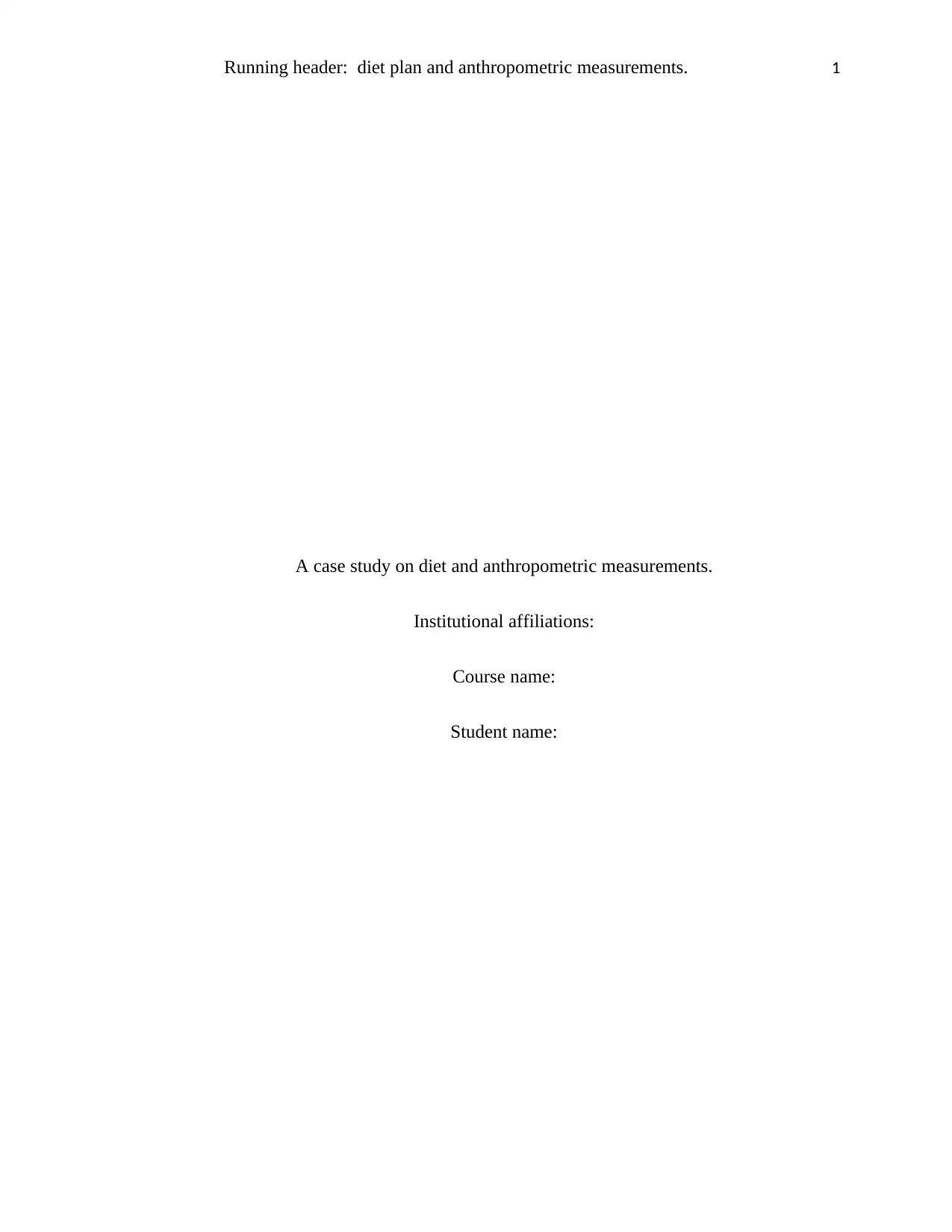
Running header: diet plan and anthropometric measurements. 1
A case study on diet and anthropometric measurements.
Institutional affiliations:
Course name:
Student name:
A case study on diet and anthropometric measurements.
Institutional affiliations:
Course name:
Student name:
Paraphrase This Document
Need a fresh take? Get an instant paraphrase of this document with our AI Paraphraser
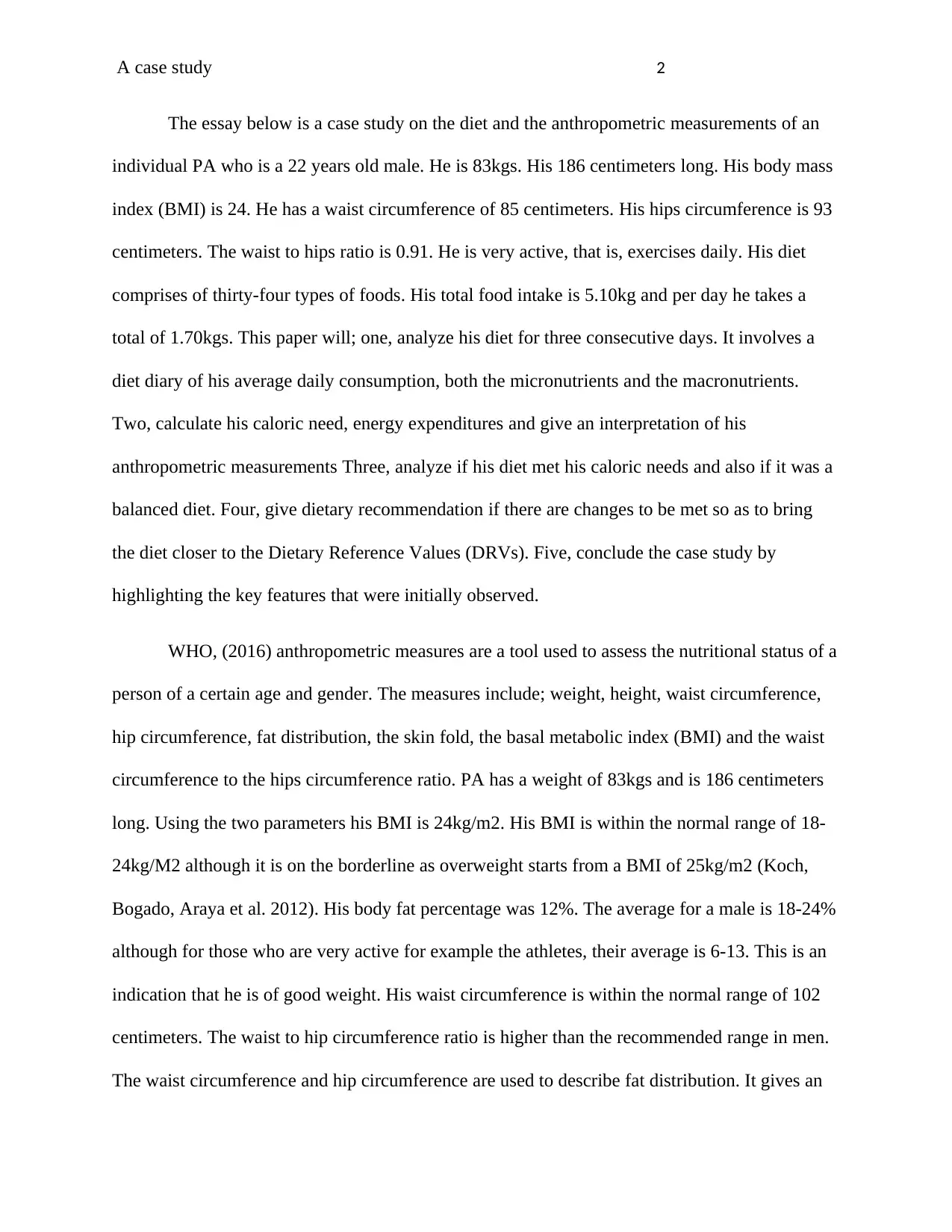
A case study 2
The essay below is a case study on the diet and the anthropometric measurements of an
individual PA who is a 22 years old male. He is 83kgs. His 186 centimeters long. His body mass
index (BMI) is 24. He has a waist circumference of 85 centimeters. His hips circumference is 93
centimeters. The waist to hips ratio is 0.91. He is very active, that is, exercises daily. His diet
comprises of thirty-four types of foods. His total food intake is 5.10kg and per day he takes a
total of 1.70kgs. This paper will; one, analyze his diet for three consecutive days. It involves a
diet diary of his average daily consumption, both the micronutrients and the macronutrients.
Two, calculate his caloric need, energy expenditures and give an interpretation of his
anthropometric measurements Three, analyze if his diet met his caloric needs and also if it was a
balanced diet. Four, give dietary recommendation if there are changes to be met so as to bring
the diet closer to the Dietary Reference Values (DRVs). Five, conclude the case study by
highlighting the key features that were initially observed.
WHO, (2016) anthropometric measures are a tool used to assess the nutritional status of a
person of a certain age and gender. The measures include; weight, height, waist circumference,
hip circumference, fat distribution, the skin fold, the basal metabolic index (BMI) and the waist
circumference to the hips circumference ratio. PA has a weight of 83kgs and is 186 centimeters
long. Using the two parameters his BMI is 24kg/m2. His BMI is within the normal range of 18-
24kg/M2 although it is on the borderline as overweight starts from a BMI of 25kg/m2 (Koch,
Bogado, Araya et al. 2012). His body fat percentage was 12%. The average for a male is 18-24%
although for those who are very active for example the athletes, their average is 6-13. This is an
indication that he is of good weight. His waist circumference is within the normal range of 102
centimeters. The waist to hip circumference ratio is higher than the recommended range in men.
The waist circumference and hip circumference are used to describe fat distribution. It gives an
The essay below is a case study on the diet and the anthropometric measurements of an
individual PA who is a 22 years old male. He is 83kgs. His 186 centimeters long. His body mass
index (BMI) is 24. He has a waist circumference of 85 centimeters. His hips circumference is 93
centimeters. The waist to hips ratio is 0.91. He is very active, that is, exercises daily. His diet
comprises of thirty-four types of foods. His total food intake is 5.10kg and per day he takes a
total of 1.70kgs. This paper will; one, analyze his diet for three consecutive days. It involves a
diet diary of his average daily consumption, both the micronutrients and the macronutrients.
Two, calculate his caloric need, energy expenditures and give an interpretation of his
anthropometric measurements Three, analyze if his diet met his caloric needs and also if it was a
balanced diet. Four, give dietary recommendation if there are changes to be met so as to bring
the diet closer to the Dietary Reference Values (DRVs). Five, conclude the case study by
highlighting the key features that were initially observed.
WHO, (2016) anthropometric measures are a tool used to assess the nutritional status of a
person of a certain age and gender. The measures include; weight, height, waist circumference,
hip circumference, fat distribution, the skin fold, the basal metabolic index (BMI) and the waist
circumference to the hips circumference ratio. PA has a weight of 83kgs and is 186 centimeters
long. Using the two parameters his BMI is 24kg/m2. His BMI is within the normal range of 18-
24kg/M2 although it is on the borderline as overweight starts from a BMI of 25kg/m2 (Koch,
Bogado, Araya et al. 2012). His body fat percentage was 12%. The average for a male is 18-24%
although for those who are very active for example the athletes, their average is 6-13. This is an
indication that he is of good weight. His waist circumference is within the normal range of 102
centimeters. The waist to hip circumference ratio is higher than the recommended range in men.
The waist circumference and hip circumference are used to describe fat distribution. It gives an
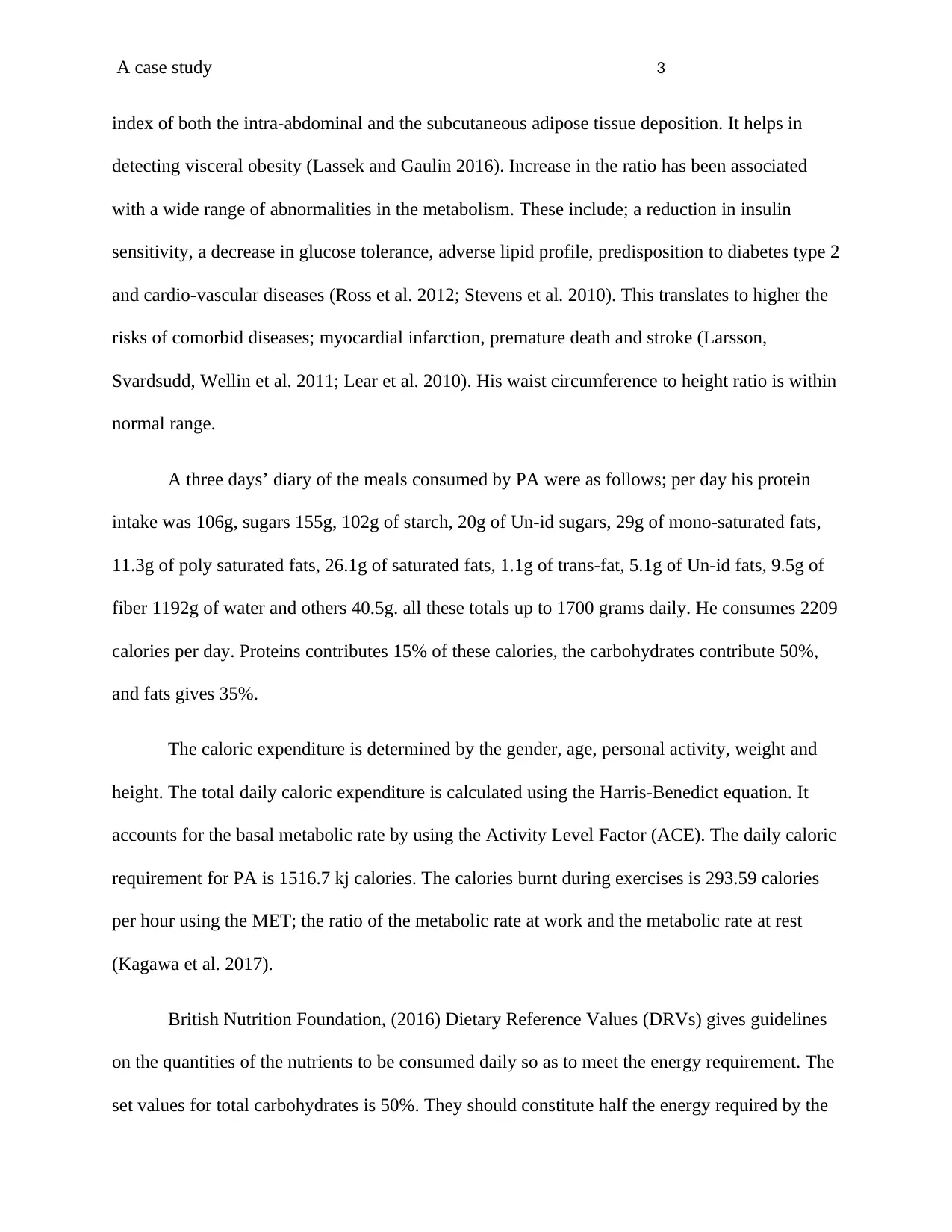
A case study 3
index of both the intra-abdominal and the subcutaneous adipose tissue deposition. It helps in
detecting visceral obesity (Lassek and Gaulin 2016). Increase in the ratio has been associated
with a wide range of abnormalities in the metabolism. These include; a reduction in insulin
sensitivity, a decrease in glucose tolerance, adverse lipid profile, predisposition to diabetes type 2
and cardio-vascular diseases (Ross et al. 2012; Stevens et al. 2010). This translates to higher the
risks of comorbid diseases; myocardial infarction, premature death and stroke (Larsson,
Svardsudd, Wellin et al. 2011; Lear et al. 2010). His waist circumference to height ratio is within
normal range.
A three days’ diary of the meals consumed by PA were as follows; per day his protein
intake was 106g, sugars 155g, 102g of starch, 20g of Un-id sugars, 29g of mono-saturated fats,
11.3g of poly saturated fats, 26.1g of saturated fats, 1.1g of trans-fat, 5.1g of Un-id fats, 9.5g of
fiber 1192g of water and others 40.5g. all these totals up to 1700 grams daily. He consumes 2209
calories per day. Proteins contributes 15% of these calories, the carbohydrates contribute 50%,
and fats gives 35%.
The caloric expenditure is determined by the gender, age, personal activity, weight and
height. The total daily caloric expenditure is calculated using the Harris-Benedict equation. It
accounts for the basal metabolic rate by using the Activity Level Factor (ACE). The daily caloric
requirement for PA is 1516.7 kj calories. The calories burnt during exercises is 293.59 calories
per hour using the MET; the ratio of the metabolic rate at work and the metabolic rate at rest
(Kagawa et al. 2017).
British Nutrition Foundation, (2016) Dietary Reference Values (DRVs) gives guidelines
on the quantities of the nutrients to be consumed daily so as to meet the energy requirement. The
set values for total carbohydrates is 50%. They should constitute half the energy required by the
index of both the intra-abdominal and the subcutaneous adipose tissue deposition. It helps in
detecting visceral obesity (Lassek and Gaulin 2016). Increase in the ratio has been associated
with a wide range of abnormalities in the metabolism. These include; a reduction in insulin
sensitivity, a decrease in glucose tolerance, adverse lipid profile, predisposition to diabetes type 2
and cardio-vascular diseases (Ross et al. 2012; Stevens et al. 2010). This translates to higher the
risks of comorbid diseases; myocardial infarction, premature death and stroke (Larsson,
Svardsudd, Wellin et al. 2011; Lear et al. 2010). His waist circumference to height ratio is within
normal range.
A three days’ diary of the meals consumed by PA were as follows; per day his protein
intake was 106g, sugars 155g, 102g of starch, 20g of Un-id sugars, 29g of mono-saturated fats,
11.3g of poly saturated fats, 26.1g of saturated fats, 1.1g of trans-fat, 5.1g of Un-id fats, 9.5g of
fiber 1192g of water and others 40.5g. all these totals up to 1700 grams daily. He consumes 2209
calories per day. Proteins contributes 15% of these calories, the carbohydrates contribute 50%,
and fats gives 35%.
The caloric expenditure is determined by the gender, age, personal activity, weight and
height. The total daily caloric expenditure is calculated using the Harris-Benedict equation. It
accounts for the basal metabolic rate by using the Activity Level Factor (ACE). The daily caloric
requirement for PA is 1516.7 kj calories. The calories burnt during exercises is 293.59 calories
per hour using the MET; the ratio of the metabolic rate at work and the metabolic rate at rest
(Kagawa et al. 2017).
British Nutrition Foundation, (2016) Dietary Reference Values (DRVs) gives guidelines
on the quantities of the nutrients to be consumed daily so as to meet the energy requirement. The
set values for total carbohydrates is 50%. They should constitute half the energy required by the
⊘ This is a preview!⊘
Do you want full access?
Subscribe today to unlock all pages.

Trusted by 1+ million students worldwide
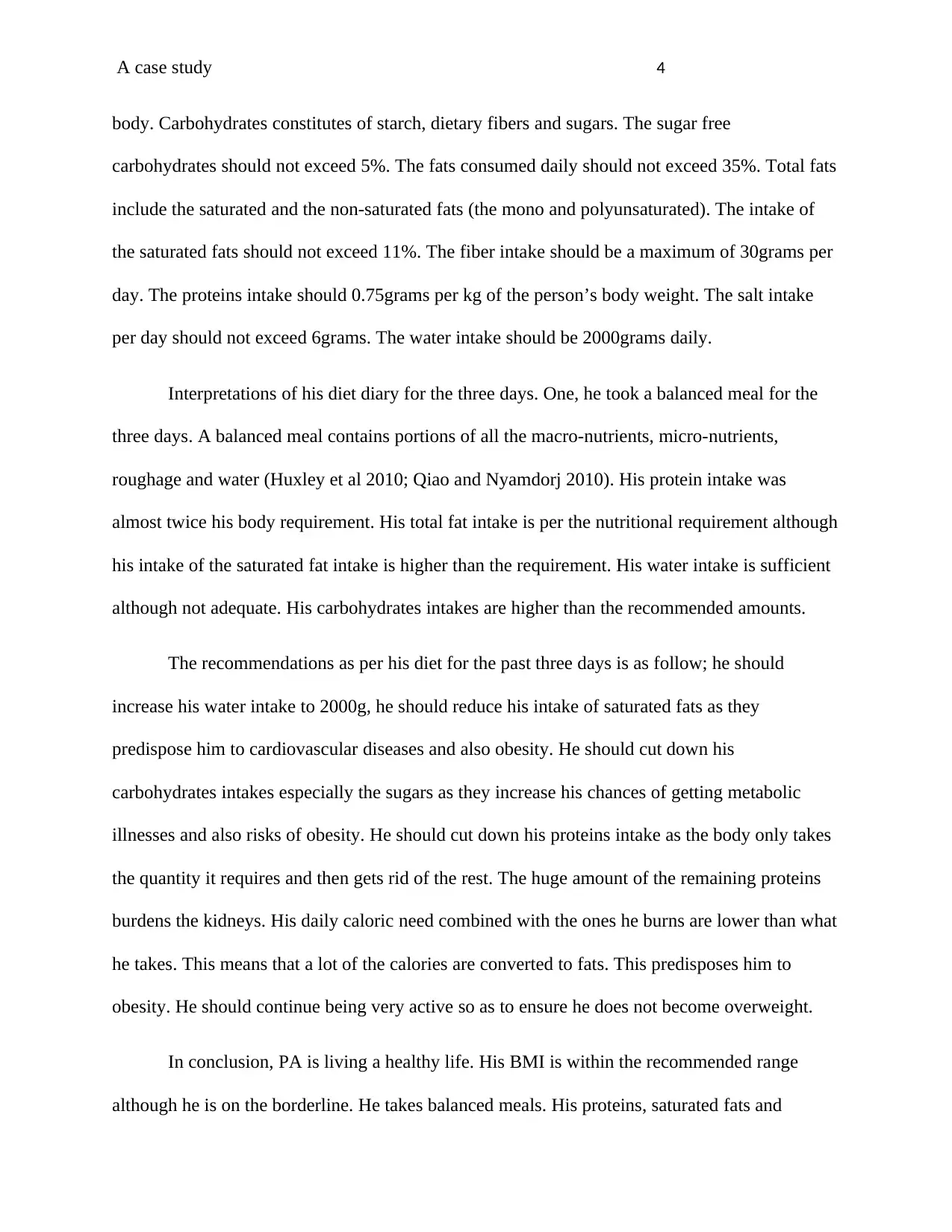
A case study 4
body. Carbohydrates constitutes of starch, dietary fibers and sugars. The sugar free
carbohydrates should not exceed 5%. The fats consumed daily should not exceed 35%. Total fats
include the saturated and the non-saturated fats (the mono and polyunsaturated). The intake of
the saturated fats should not exceed 11%. The fiber intake should be a maximum of 30grams per
day. The proteins intake should 0.75grams per kg of the person’s body weight. The salt intake
per day should not exceed 6grams. The water intake should be 2000grams daily.
Interpretations of his diet diary for the three days. One, he took a balanced meal for the
three days. A balanced meal contains portions of all the macro-nutrients, micro-nutrients,
roughage and water (Huxley et al 2010; Qiao and Nyamdorj 2010). His protein intake was
almost twice his body requirement. His total fat intake is per the nutritional requirement although
his intake of the saturated fat intake is higher than the requirement. His water intake is sufficient
although not adequate. His carbohydrates intakes are higher than the recommended amounts.
The recommendations as per his diet for the past three days is as follow; he should
increase his water intake to 2000g, he should reduce his intake of saturated fats as they
predispose him to cardiovascular diseases and also obesity. He should cut down his
carbohydrates intakes especially the sugars as they increase his chances of getting metabolic
illnesses and also risks of obesity. He should cut down his proteins intake as the body only takes
the quantity it requires and then gets rid of the rest. The huge amount of the remaining proteins
burdens the kidneys. His daily caloric need combined with the ones he burns are lower than what
he takes. This means that a lot of the calories are converted to fats. This predisposes him to
obesity. He should continue being very active so as to ensure he does not become overweight.
In conclusion, PA is living a healthy life. His BMI is within the recommended range
although he is on the borderline. He takes balanced meals. His proteins, saturated fats and
body. Carbohydrates constitutes of starch, dietary fibers and sugars. The sugar free
carbohydrates should not exceed 5%. The fats consumed daily should not exceed 35%. Total fats
include the saturated and the non-saturated fats (the mono and polyunsaturated). The intake of
the saturated fats should not exceed 11%. The fiber intake should be a maximum of 30grams per
day. The proteins intake should 0.75grams per kg of the person’s body weight. The salt intake
per day should not exceed 6grams. The water intake should be 2000grams daily.
Interpretations of his diet diary for the three days. One, he took a balanced meal for the
three days. A balanced meal contains portions of all the macro-nutrients, micro-nutrients,
roughage and water (Huxley et al 2010; Qiao and Nyamdorj 2010). His protein intake was
almost twice his body requirement. His total fat intake is per the nutritional requirement although
his intake of the saturated fat intake is higher than the requirement. His water intake is sufficient
although not adequate. His carbohydrates intakes are higher than the recommended amounts.
The recommendations as per his diet for the past three days is as follow; he should
increase his water intake to 2000g, he should reduce his intake of saturated fats as they
predispose him to cardiovascular diseases and also obesity. He should cut down his
carbohydrates intakes especially the sugars as they increase his chances of getting metabolic
illnesses and also risks of obesity. He should cut down his proteins intake as the body only takes
the quantity it requires and then gets rid of the rest. The huge amount of the remaining proteins
burdens the kidneys. His daily caloric need combined with the ones he burns are lower than what
he takes. This means that a lot of the calories are converted to fats. This predisposes him to
obesity. He should continue being very active so as to ensure he does not become overweight.
In conclusion, PA is living a healthy life. His BMI is within the recommended range
although he is on the borderline. He takes balanced meals. His proteins, saturated fats and
Paraphrase This Document
Need a fresh take? Get an instant paraphrase of this document with our AI Paraphraser
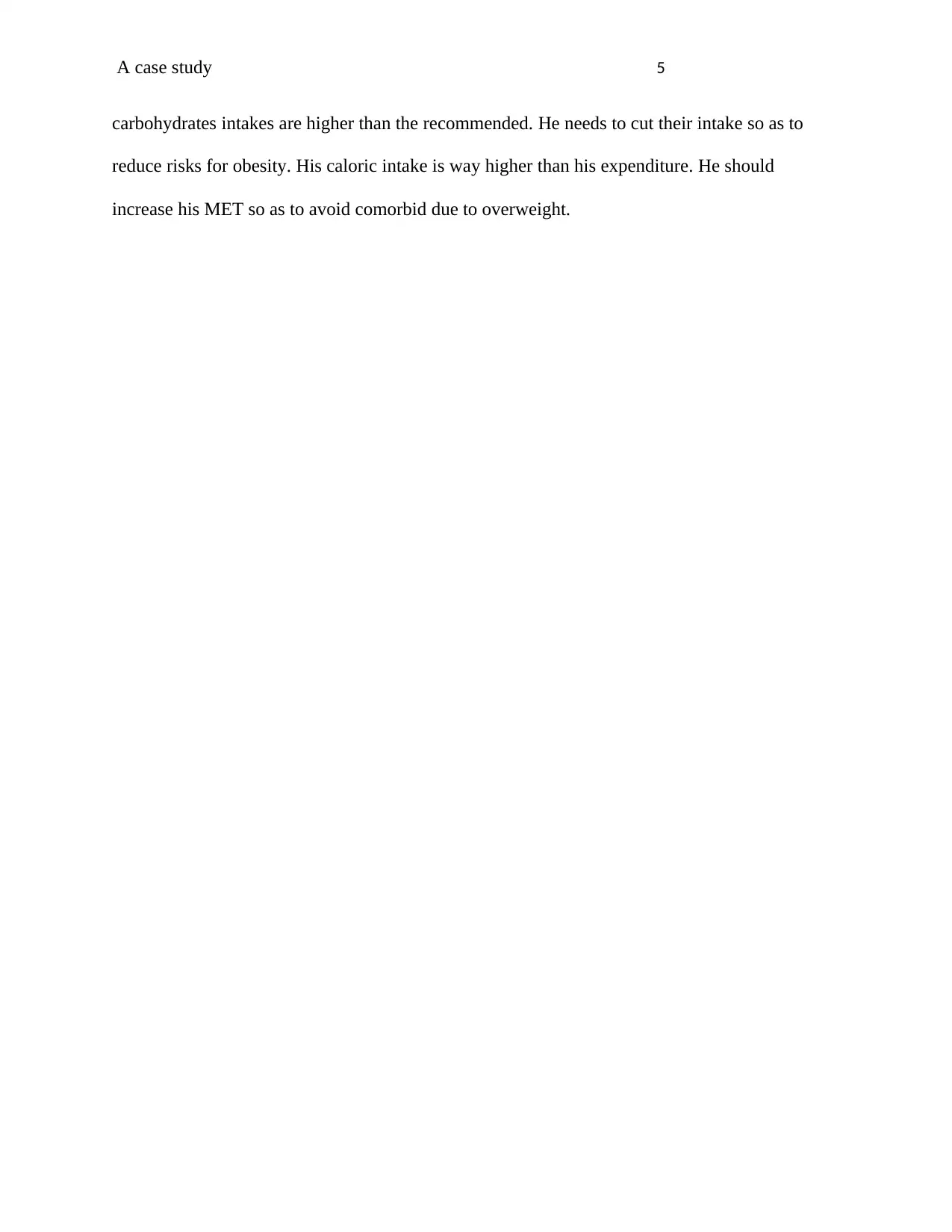
A case study 5
carbohydrates intakes are higher than the recommended. He needs to cut their intake so as to
reduce risks for obesity. His caloric intake is way higher than his expenditure. He should
increase his MET so as to avoid comorbid due to overweight.
carbohydrates intakes are higher than the recommended. He needs to cut their intake so as to
reduce risks for obesity. His caloric intake is way higher than his expenditure. He should
increase his MET so as to avoid comorbid due to overweight.
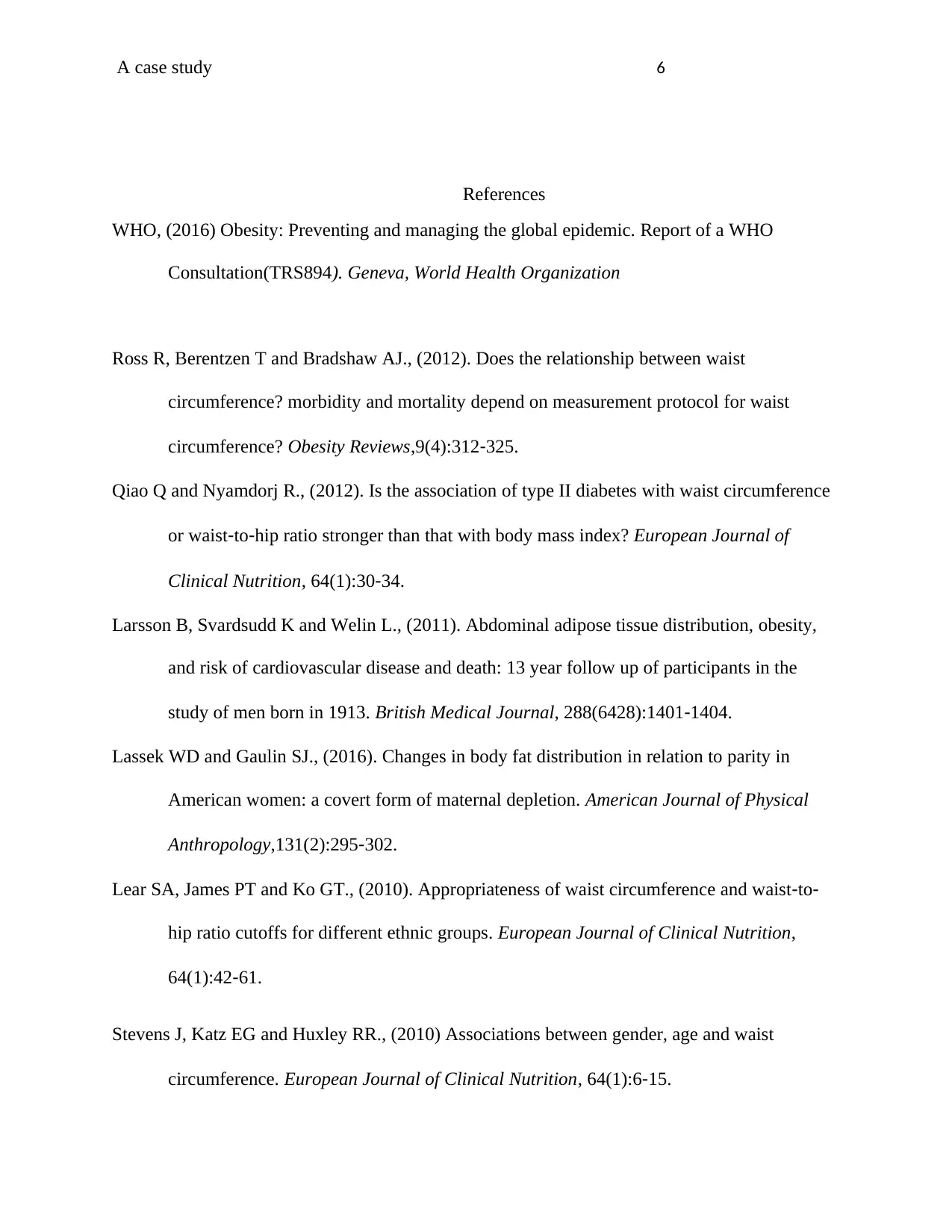
A case study 6
References
WHO, (2016) Obesity: Preventing and managing the global epidemic. Report of a WHO
Consultation(TRS894). Geneva, World Health Organization
Ross R, Berentzen T and Bradshaw AJ., (2012). Does the relationship between waist
circumference? morbidity and mortality depend on measurement protocol for waist
circumference? Obesity Reviews,9(4):312‐325.
Qiao Q and Nyamdorj R., (2012). Is the association of type II diabetes with waist circumference
or waist‐to‐hip ratio stronger than that with body mass index? European Journal of
Clinical Nutrition, 64(1):30‐34.
Larsson B, Svardsudd K and Welin L., (2011). Abdominal adipose tissue distribution, obesity,
and risk of cardiovascular disease and death: 13 year follow up of participants in the
study of men born in 1913. British Medical Journal, 288(6428):1401‐1404.
Lassek WD and Gaulin SJ., (2016). Changes in body fat distribution in relation to parity in
American women: a covert form of maternal depletion. American Journal of Physical
Anthropology,131(2):295‐302.
Lear SA, James PT and Ko GT., (2010). Appropriateness of waist circumference and waist‐to‐
hip ratio cutoffs for different ethnic groups. European Journal of Clinical Nutrition,
64(1):42‐61.
Stevens J, Katz EG and Huxley RR., (2010) Associations between gender, age and waist
circumference. European Journal of Clinical Nutrition, 64(1):6‐15.
References
WHO, (2016) Obesity: Preventing and managing the global epidemic. Report of a WHO
Consultation(TRS894). Geneva, World Health Organization
Ross R, Berentzen T and Bradshaw AJ., (2012). Does the relationship between waist
circumference? morbidity and mortality depend on measurement protocol for waist
circumference? Obesity Reviews,9(4):312‐325.
Qiao Q and Nyamdorj R., (2012). Is the association of type II diabetes with waist circumference
or waist‐to‐hip ratio stronger than that with body mass index? European Journal of
Clinical Nutrition, 64(1):30‐34.
Larsson B, Svardsudd K and Welin L., (2011). Abdominal adipose tissue distribution, obesity,
and risk of cardiovascular disease and death: 13 year follow up of participants in the
study of men born in 1913. British Medical Journal, 288(6428):1401‐1404.
Lassek WD and Gaulin SJ., (2016). Changes in body fat distribution in relation to parity in
American women: a covert form of maternal depletion. American Journal of Physical
Anthropology,131(2):295‐302.
Lear SA, James PT and Ko GT., (2010). Appropriateness of waist circumference and waist‐to‐
hip ratio cutoffs for different ethnic groups. European Journal of Clinical Nutrition,
64(1):42‐61.
Stevens J, Katz EG and Huxley RR., (2010) Associations between gender, age and waist
circumference. European Journal of Clinical Nutrition, 64(1):6‐15.
⊘ This is a preview!⊘
Do you want full access?
Subscribe today to unlock all pages.

Trusted by 1+ million students worldwide
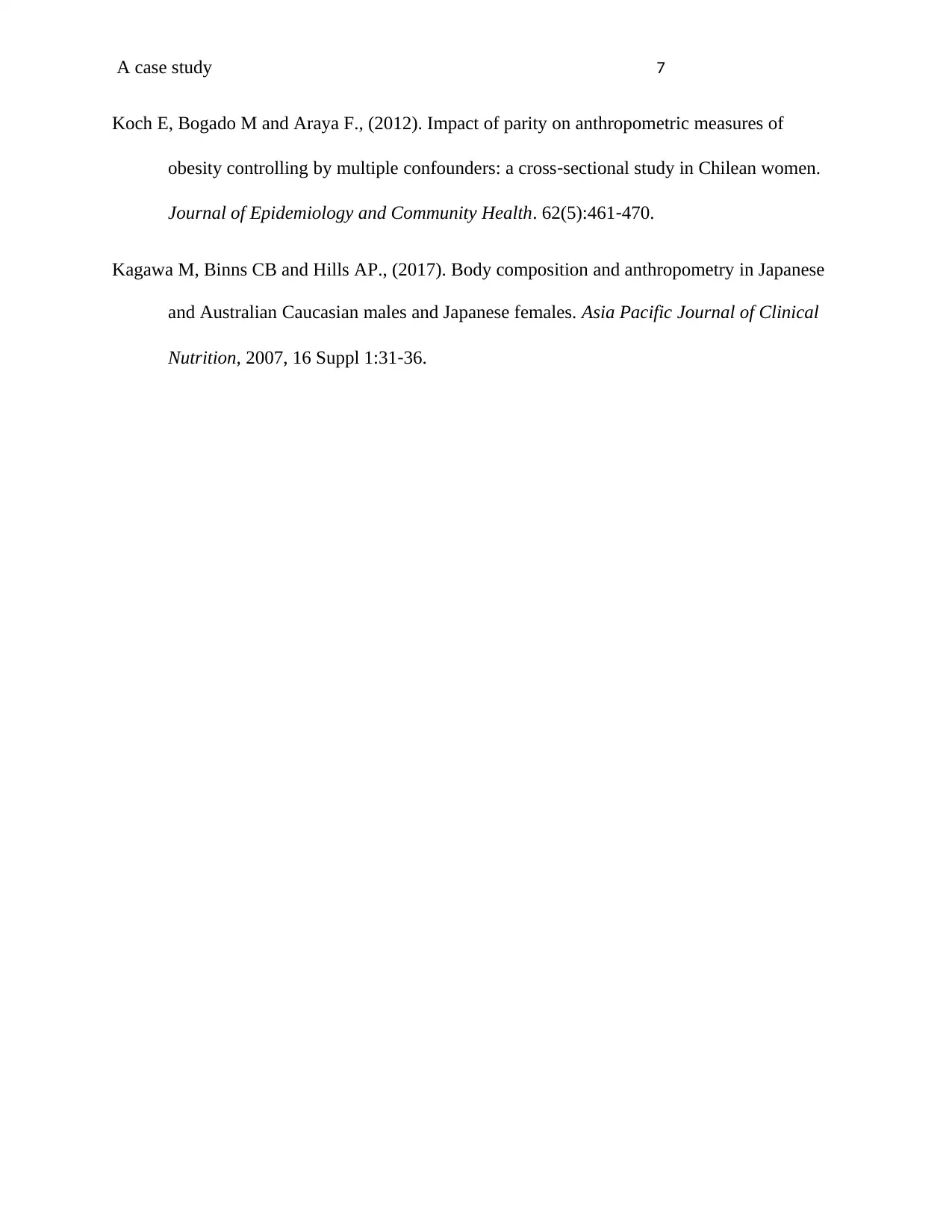
A case study 7
Koch E, Bogado M and Araya F., (2012). Impact of parity on anthropometric measures of
obesity controlling by multiple confounders: a cross‐sectional study in Chilean women.
Journal of Epidemiology and Community Health. 62(5):461‐470.
Kagawa M, Binns CB and Hills AP., (2017). Body composition and anthropometry in Japanese
and Australian Caucasian males and Japanese females. Asia Pacific Journal of Clinical
Nutrition, 2007, 16 Suppl 1:31‐36.
Koch E, Bogado M and Araya F., (2012). Impact of parity on anthropometric measures of
obesity controlling by multiple confounders: a cross‐sectional study in Chilean women.
Journal of Epidemiology and Community Health. 62(5):461‐470.
Kagawa M, Binns CB and Hills AP., (2017). Body composition and anthropometry in Japanese
and Australian Caucasian males and Japanese females. Asia Pacific Journal of Clinical
Nutrition, 2007, 16 Suppl 1:31‐36.
Paraphrase This Document
Need a fresh take? Get an instant paraphrase of this document with our AI Paraphraser
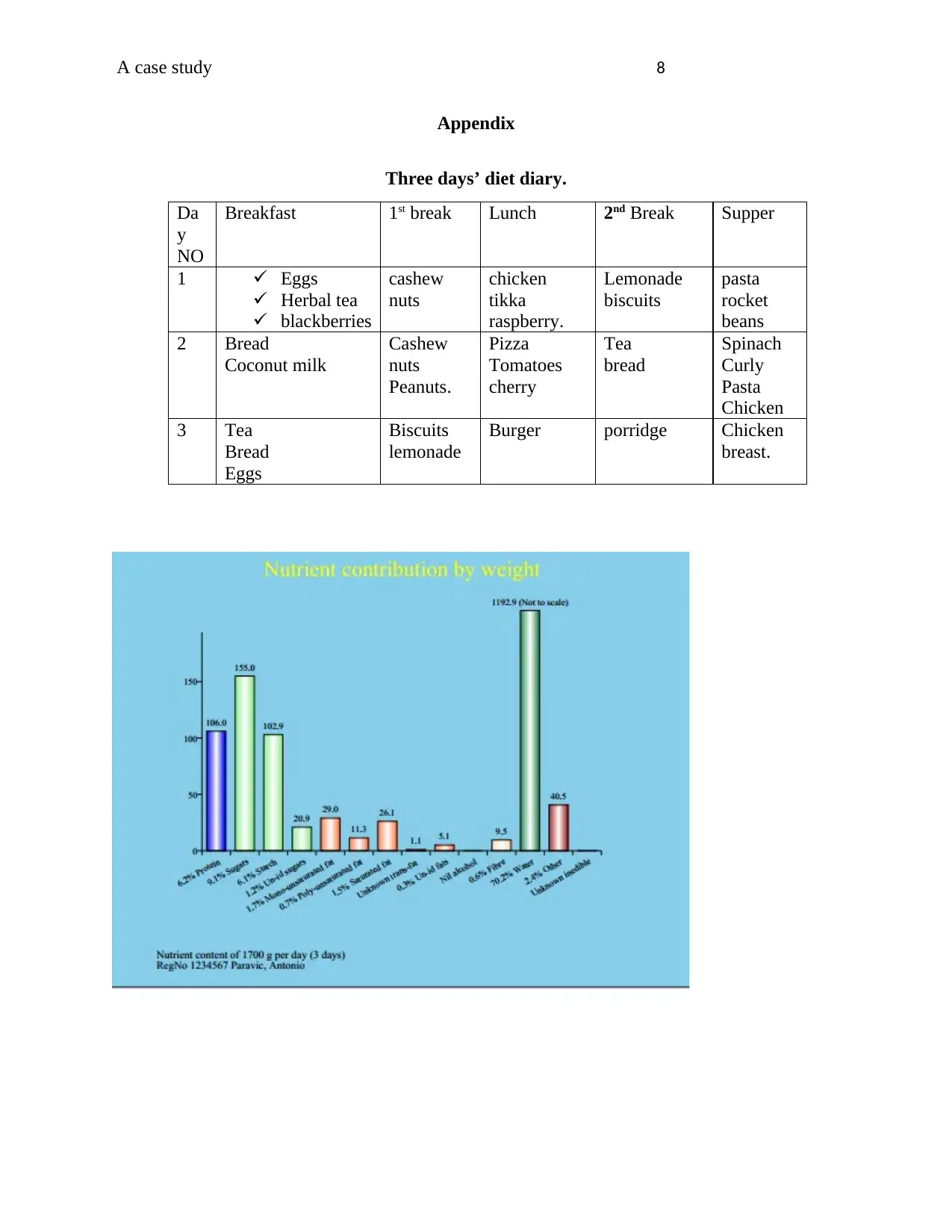
A case study 8
Appendix
Three days’ diet diary.
Da
y
NO
Breakfast 1st break Lunch 2nd Break Supper
1 Eggs
Herbal tea
blackberries
cashew
nuts
chicken
tikka
raspberry.
Lemonade
biscuits
pasta
rocket
beans
2 Bread
Coconut milk
Cashew
nuts
Peanuts.
Pizza
Tomatoes
cherry
Tea
bread
Spinach
Curly
Pasta
Chicken
3 Tea
Bread
Eggs
Biscuits
lemonade
Burger porridge Chicken
breast.
Appendix
Three days’ diet diary.
Da
y
NO
Breakfast 1st break Lunch 2nd Break Supper
1 Eggs
Herbal tea
blackberries
cashew
nuts
chicken
tikka
raspberry.
Lemonade
biscuits
pasta
rocket
beans
2 Bread
Coconut milk
Cashew
nuts
Peanuts.
Pizza
Tomatoes
cherry
Tea
bread
Spinach
Curly
Pasta
Chicken
3 Tea
Bread
Eggs
Biscuits
lemonade
Burger porridge Chicken
breast.
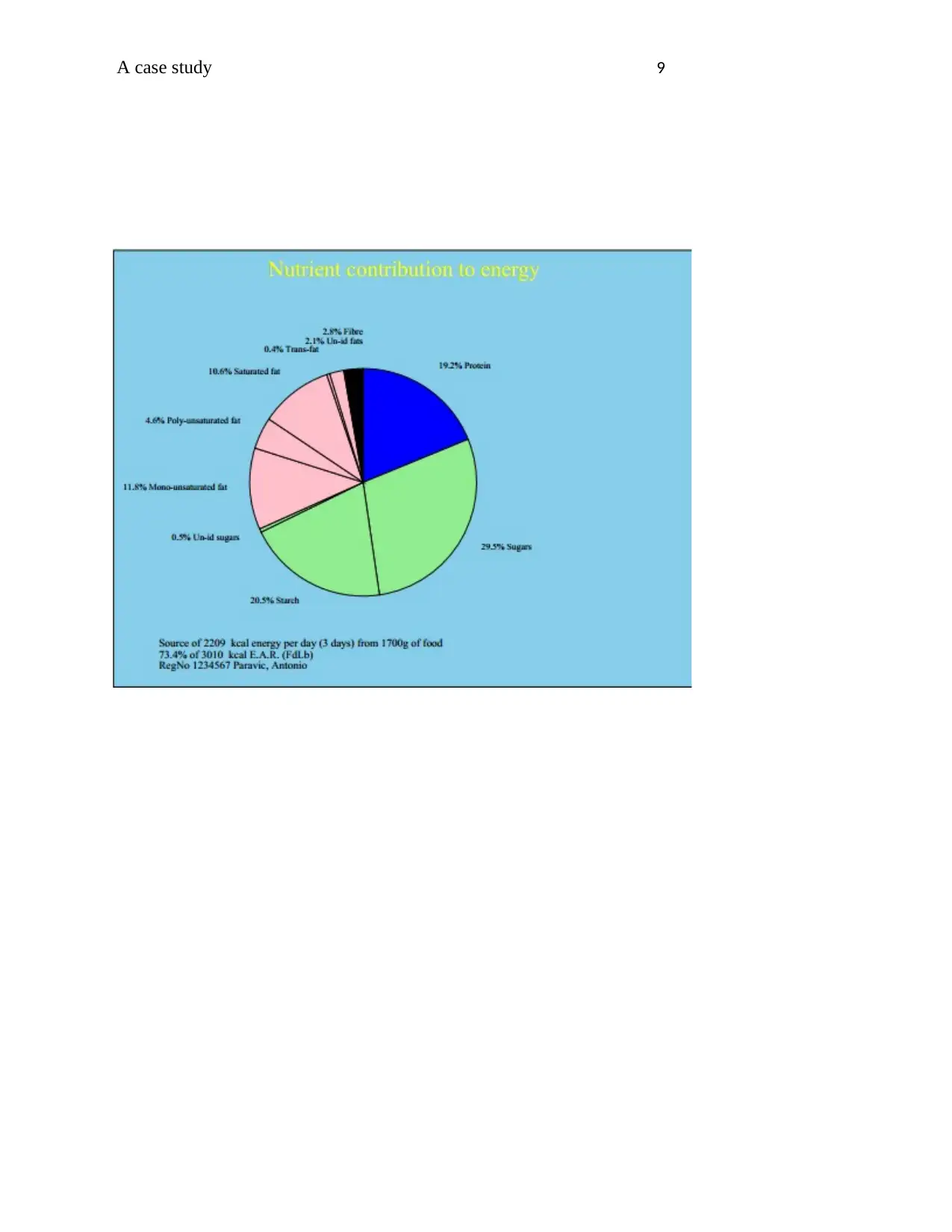
A case study 9
⊘ This is a preview!⊘
Do you want full access?
Subscribe today to unlock all pages.

Trusted by 1+ million students worldwide
1 out of 9
Related Documents
Your All-in-One AI-Powered Toolkit for Academic Success.
+13062052269
info@desklib.com
Available 24*7 on WhatsApp / Email
![[object Object]](/_next/static/media/star-bottom.7253800d.svg)
Unlock your academic potential
Copyright © 2020–2025 A2Z Services. All Rights Reserved. Developed and managed by ZUCOL.





